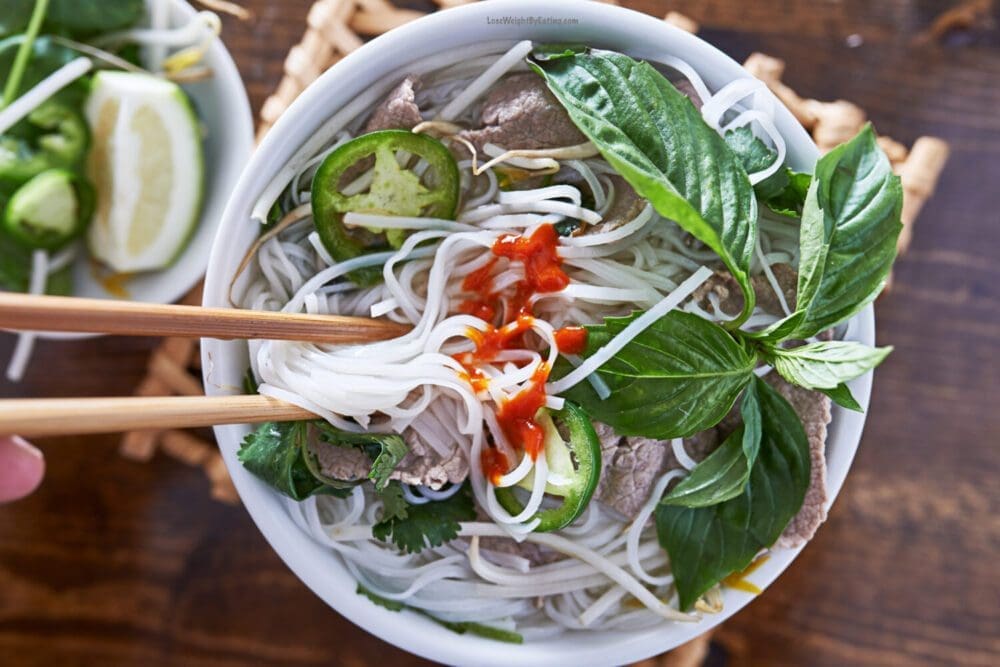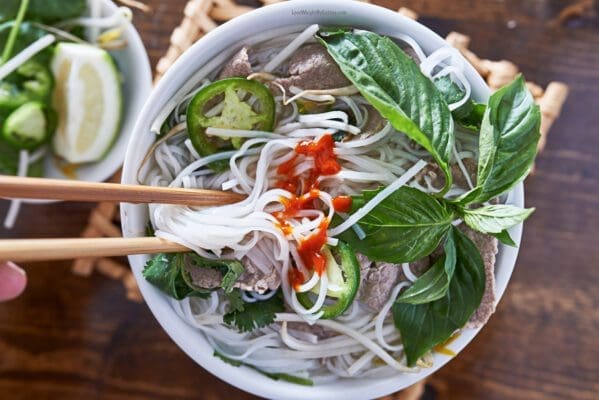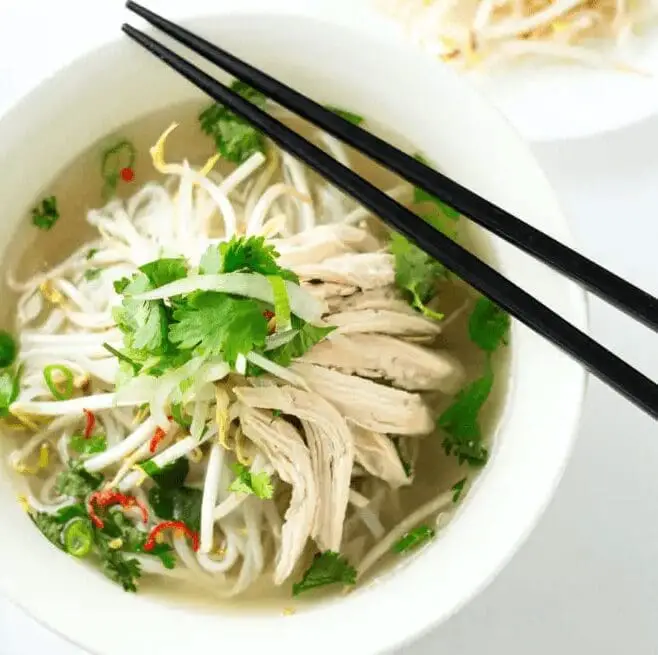Learn how many calories are in Pho, how to order Pho in a low calorie way. Plus the nutrition and calories in different types of Pho, the calorie sin the toppings and even find a low calorie recipe to make at home.
This guide will supply you with everything you need to keep your next pho order low calorie and healthy.


Pho is a traditional Vietnamese noodle soup made with a savory broth, rice noodles, herbs, and meat. This dish has become increasingly popular in recent years due to its unique flavor and health benefits.
However, for those who are watching their calorie intake, the question of “How many calories in pho?” may arise. In this article, I’ll share the calorie content of this popular dish and provide tips on how to enjoy it without breaking your calorie budget.
Is Pho Healthy?
Pho is generally considered to be a healthy dish due to its nutritious ingredients and low calorie content. Here are some reasons why pho can be a healthy option:
- Nutritious Ingredients: Pho is typically made with a variety of nutritious ingredients, including fresh herbs, vegetables, and lean proteins like chicken or beef. These ingredients provide a range of essential vitamins and minerals, such as vitamins A and C, iron, and calcium.
- Low Calorie Content: A typical bowl of pho contains between 300-450 calories (more info on calories below), which makes it a great option for those looking to watch their calorie intake. By choosing a clear broth and lean protein, you can enjoy a filling and satisfying meal without consuming excessive calories.
- Hydration: Pho broth is high in water content, which can help keep you hydrated throughout the day. Adequate hydration is important for many aspects of health, including digestion, skin health, and energy levels.
- Digestive Health: Pho broth is often made with animal bones, which contain collagen. Collagen is great for supporting digestive health, as it can help to reduce inflammation and protect the lining of the digestive tract.
- Gluten-Free Option: Pho noodles are typically made with rice flour, which makes them a great option for those who are gluten-free or have celiac disease.
However, it’s important to keep in mind that the nutritional content of pho can vary depending on the specific ingredients used and preparation method. For example, if the broth is made with a lot of oil or if the protein used is fatty, the calorie and fat content can be higher.
Overall, pho can be a healthy option if you choose ingredients wisely and pay attention to the nutritional content. By opting for a clear broth, lean protein, and plenty of vegetables, you can enjoy a delicious and nutritious meal.
Tips for Enjoying Pho Without Breaking Your Calorie Bank
If you’re watching your calorie intake, there are some tips you can follow to enjoy pho without consuming too many calories:
- Choose lean protein: Opt for lean protein options such as chicken, shrimp, or tofu instead of high-fat meats like beef or pork.
- Watch your portion size: Stick to a small or medium-sized bowl of pho to keep your calorie intake in check.
- Go easy on the noodles: Rice noodles are high in carbohydrates and can add up in calories quickly. Consider asking for half the amount of noodles or skipping them altogether.
- Load up on vegetables: Pho is typically served with a variety of vegetables such as bean sprouts, cilantro, and lime wedges. Load up on these low-calorie, nutrient-dense foods to add flavor and nutrition to your meal.
How Many Calories in Pho? Let’s Find Out!
Pho is a nutrient-dense dish that contains a variety of ingredients, including vegetables, herbs, and protein.
The calorie count of pho can vary depending on the ingredients used and the serving size. Let’s take a closer look at the calorie count of some popular pho dishes:
Chicken Pho Calories
A typical serving of chicken pho contains around 350-400 calories. This includes a serving of chicken, rice noodles, and broth.
- Serving size: 1 bowl (approximately 2 cups)
- Calories: 350-400
- Fat: 4-6 grams
- Carbohydrates: 50-60 grams
- Protein: 30-35 grams
- Fiber: 3-5 grams
- Sodium: 700-900 milligrams
Beef Pho Calories
A serving of beef pho typically contains around 400-450 calories. This includes a serving of beef, rice noodles, and broth.
- Serving size: 1 bowl (approximately 2 cups)
- Calories: 400-450
- Fat: 6-8 grams
- Carbohydrates: 50-60 grams
- Protein: 30-35 grams
- Fiber: 3-5 grams
- Sodium: 800-1000 milligrams
Vegetarian Pho Calories
A serving of vegetarian pho typically contains around 250-300 calories. This includes a serving of tofu, rice noodles, and broth.
- Serving size: 1 bowl (approximately 2 cups)
- Calories: 250-300
- Fat: 2-4 grams
- Carbohydrates: 40-50 grams
- Protein: 15-20 grams
- Fiber: 3-5 grams
- Sodium: 500-700 milligrams
As you can see, the calorie count of pho can vary depending on the ingredients used and the serving size. However, pho is generally considered a healthy meal option as it is low in fat and high in protein and fiber.
Calories in Pho Toppings
Pho is often served with a variety of toppings, such as bean sprouts, herbs, lime wedges, jalapeño slices, and hoisin sauce. While these toppings can add flavor and texture to the dish, they can also add calories.
Here is a breakdown of the approximate calories in some common pho toppings:
- Bean sprouts (1 cup): 30 calories
- Basil leaves (10 leaves): 1 calorie
- Cilantro (1/4 cup): 1 calorie
- Jalapeño slices (2 tablespoons): 4 calories
- Lime wedge (1 wedge): 1 calorie
- Hoisin sauce (1 tablespoon): 50 calories
- Sriracha sauce (1 tablespoon): 5 calories
Keep in mind that these are rough estimates and the calorie counts may vary depending on the quantity and specific brand of the toppings used.
If you’re trying to keep your calorie intake in check, it’s a good idea to use toppings sparingly or skip them altogether. Alternatively, you can opt for lower calorie toppings like herbs and lime wedges instead of high calorie sauces like hoisin sauce.
Health Benefits of Pho
Pho is more than just a delicious and comforting dish. It is also packed with health benefits, making it a great addition to any diet. Here are some of the healthy benefits of pho:
- Provides Essential Nutrients: Pho is typically made with nutrient-rich ingredients like rice noodles, fresh herbs, and vegetables. It is also a great source of protein, with options like chicken, beef, and tofu.
- Supports Immune Function: Many of the ingredients in pho, like ginger, garlic, and onion, have anti-inflammatory and immune-boosting properties. This can help support your immune function and overall health.
- Promotes Digestive Health: Pho broth is rich in collagen, which is great for supporting digestive health. Collagen helps to protect the lining of the digestive tract and may reduce inflammation.
- Hydrates the Body: Pho broth is a great source of hydration, which is important for maintaining good health. The high water content in the broth can also help to flush toxins from the body.
- Supports Bone Health: Pho broth is often made with animal bones, which are a great source of minerals like calcium and magnesium. These minerals are important for maintaining healthy bones and teeth.
- May Aid in Weight Loss: Pho is a low-calorie and filling meal that can be a great option for those looking to lose weight. By opting for a clear broth, lean protein, and plenty of vegetables, you can create a healthy and satisfying meal that won’t sabotage your weight loss goals.
By incorporating pho into your diet, you can enjoy its delicious taste while reaping the many health benefits it has to offer.
10 Ways to Lower the Calories in Pho:
- Choose a lean protein: Opt for chicken or tofu instead of beef, as they are typically lower in calories and saturated fat.
- Skip the fried toppings: Fried onion, garlic, or shallots are often used as a topping in pho, but they can add a significant amount of calories. Consider skipping them or using a small amount of sautéed onions instead.
- Use less noodles: Noodles are a staple ingredient in pho, but they can also contribute a significant amount of calories. Consider using less noodles or opting for a vegetable-based noodle like zucchini or sweet potato noodles.
- Choose a clear broth: Some pho broths are made with added oils, which can increase the calorie count. Opt for a clear broth instead, which is typically lower in calories.
- Go easy on the sauces: Hoisin sauce, sriracha, and other condiments can add flavor to your pho, but they also add calories. Use them sparingly or skip them altogether.
- Add extra veggies: Add extra vegetables to your pho, like bean sprouts, bok choy, or mushrooms. They will add flavor and bulk without adding many calories.
- Use a smaller bowl: Portions can be a key factor in calorie intake. Use a smaller bowl to help control your portions and limit your calorie intake.
- Don’t drink all the broth: Pho broth can be high in sodium, and drinking all of it can add to your calorie count. Consider leaving some of the broth in the bowl.
- Make your own: Making your own pho at home allows you to control the ingredients and portion sizes, making it easier to lower the calorie count.
- Enjoy pho in moderation: Pho can be a healthy and satisfying meal, but it’s important to enjoy it in moderation. Eating pho too often or in large quantities can lead to consuming more calories than you need.
By following these tips, you can enjoy pho while keeping your calorie intake in check.
How Does Pho Compare with Ramen?
Pho and ramen are both popular noodle dishes that originate from Asia, but they differ in their flavor, ingredients, and nutritional content. Here are some key differences between pho and ramen:
- Flavor: Pho has a lighter and more delicate flavor compared to ramen, which tends to be richer and more savory. Pho broth is typically made with beef bones or chicken, while ramen broth is often made with pork bones or a blend of chicken and pork bones.
- Noodles: Pho noodles are made from rice flour and are typically thinner and more delicate than ramen noodles, which are made from wheat flour and are thicker and chewier.
- Ingredients: Pho is typically made with fresh herbs like basil, cilantro, and bean sprouts, while ramen is often topped with ingredients like pork belly, eggs, and seaweed.
- Nutritional Content: Pho is generally considered to be a healthier option than ramen due to its lower calorie and fat content. However, the nutritional content can vary depending on the specific ingredients used and preparation method.
Ultimately, the choice between pho and ramen comes down to personal preference. If you prefer a lighter and more delicate flavor, pho may be the better option for you. If you prefer a richer and more savory flavor, ramen may be the way to go.
Low Calorie Pho Recipe
This reader favorite Low Calorie Pho is quick, easy and packed with nutrition! You can make it in just 30 minutes and it’s just 262 calories and has 40.9g of protein!
I know you’ll love this homemade recipe, try it out yourself and save lots of calories.
Frequently Asked Questions (FAQ)
Yes, pho is generally considered a healthy meal option as it is low in fat and high in protein and fiber.
The calorie count of pho can vary depending on the ingredients used and the serving size. A typical serving of chicken pho contains around 350-400 calories, while a serving of beef pho contains around 400-450 calories.
Yes, pho can be made at home using a variety of recipes that are readily available online or in cookbooks.
Final Thoughts
Pho is a delicious and nutritious meal option that can be enjoyed as part of a healthy diet.
While the calorie count of pho can vary depending on the ingredients used and the serving size, there are some tips you can follow to enjoy pho without consuming too many calories.
By choosing lean protein options, watching your portion size, going easy on the noodles, and loading up on vegetables
What to Read Next:






Lose Weight By Eating Cookbooks


Share this Low Calorie Guide:



